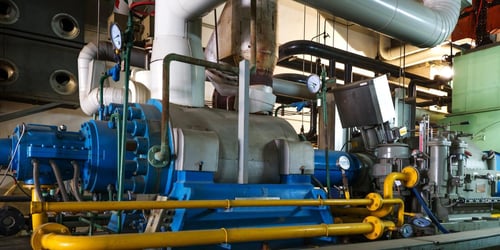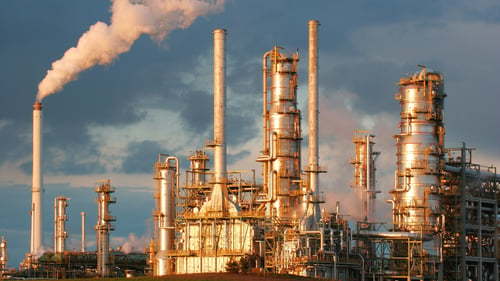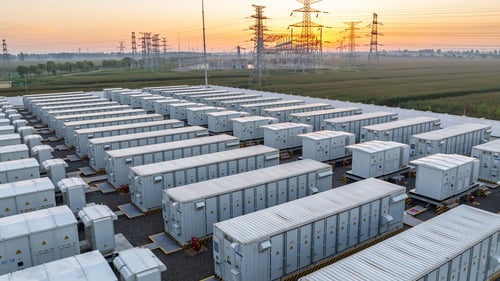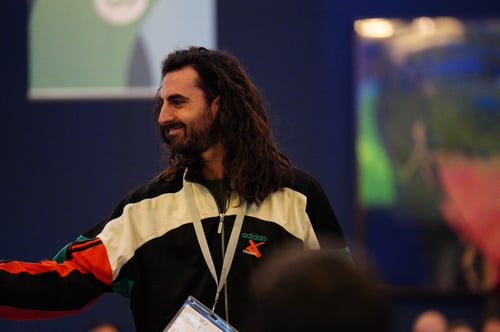smartEn Executive Director Michael Villa on the future of energy flexibility in Europe
.jpg?width=768&name=Article%20Thumbnails%20-%201920x1080%20new%20website%20(35).jpg)
When we consider how best to address Europe's energy challenges, we often focus on supply, where our energy comes from, and how to source more. Yet the other half of the equation, energy demand, when and how we use it, has an equally vital role to play. With this in mind, we recently caught up with smartEn’s Executive Director Michael Villa, a leading voice in Europe’s energy sector. In the first part of our interview, we covered how to get Europe’s grids fit for upcoming challenges. Today, we dig deeper into the future of energy flexibility, how demand response and battery storage can work together, and the role of digitisation in ramping up demand-side services.
Jump to:
- Developments in Europe's energy flexibility sector
- How demand response and BESS work together
- Data exchange between system operators and consumers
- Biggest challenge in the energy industry
- Hope to realise the energy transition
- The future of smart energy in three words
What do you see as the biggest trends and newest developments unfolding in Europe’s energy flexibility sector?
It's indisputable that we need more flexible resources to achieve a systemic clean energy transition. Beyond the traditional, non-fossil flexible resources, we need to exploit the potential of flexible demand which can be provided by decentralised energy resources in all energy end-use sectors, from homes to large energy intensive industries.
The Flexible Demand Management Industry is a vast spectrum of companies that can support the activation of flexible demand. It is made up of 5 different categories:
- Companies manufacturing decentralised energy resources
- Energy suppliers offering dynamic price contracts
- Independent aggregators
- Companies supporting the financing, management and operation of local energy initiatives, such as renewable communities and energy sharing schemes
- Independent market operators setting up market platforms
Although heterogeneous, these 5 business trends contribute to active flexible demand.
Their relevance to support an increasing flexible system is clear, their growth is noticeable, but less than expected. In terms of market developments, we should see a multiplicity of products and offers for both implicit flexibility, such as dynamic tariffs offered by suppliers, and explicit flexibility, like aggregators offering to bid into markets.
We are seeing this growth in real-time at smartEn as we recently reached a milestone of 100 members. This also reflects the broader trend of increasing recognition and awareness of the flexible demand industry.
Yet progress remains unequal across Europe, with Mediterranean countries such as Italy, Spain, Greece, and Eastern European countries lagging behind and yet to realise the potential of flexibility. Conversely, France, the Netherlands and Finland have been proactive in exploring the opportunities of flexibility across different markets and business offerings across TSO and DSO and wholesale markets.
Crucially, for all this to happen the key development we need to see is mass electrification.
BESS has been described as the key to unlocking the potential of the energy transition. How do you see demand response and BESS working together to create a sustainable energy system?
At the moment, large scale energy storage assets are the mainstream technology considered by system operators to integrate variable renewables and support the increasing system flexibility needs.
While their role is important in the clean energy transition, decentralised energy storage assets are crucial to support the increasing daily flexibility needs, along with all other decentralised energy resources.
In fact, the mass adoption of demand-side flexibility relies on the greater deployment of all decentralised energy resources, including demand management solutions, distributed storage assets and renewable generation. These Behind-the-Metre assets can unleash the potential of consumers’ energy flexibility if activated in response to external signals.
Now consumers’ flexibility is mainly provided by a single decentralised resource. In the future, it is crucial to integrate them all, allowing interoperable BTM communication to increase the flexibility potential of end-users.
When looking at distributed energy storage facilities, we should consider both static energy storage assets, such as home batteries, and mobile ones, such as batteries in electric vehicles used for bidirectional charging.
How will digitalisation advance demand-side flexibility, and why is data exchange between system operators and consumers important?
The digitisation of the entire energy system is happening. Access to energy data and data sharing to support flexibility services is an increasingly relevant economy.
Data-sharing pathways need to be established between TSOs and DSOs, between system operators and market players, and between market players, consumers, and Behind-the-Metre data.
Right now, there are predominantly proprietary approaches to data management, but the near future requires interoperable systems that utilise common APIs, and standardised data formats in a harmonised way across the EU.
In terms of legislation, we need to raise our ambitions to create a common EU data space. An Implementing regulation in DR data interoperability is already in the making, along with a digital twin of the electricity system. This digital twin, informed by vast tracts of data, will help analysts understand better how the system works, foresee energy projections and enable us to investigate better where investment is needed.
Standards and protocols to support data flows already exist, but there is currently no consensus with over 300 standards in place across the EU. smartEn is supporting work to prioritise and harmonise these standards and simplify the process of data sharing cross-continentally.
Looking back on your career and years of experience, what has been the biggest change you’ve seen in the energy industry?
In 2011, when I started my professional career, I was working for an energy efficiency business community. At the time, there was a struggle to position the value proposition of energy efficiency towards EU policymakers.
Similarly, until 10 years ago, small projects and businesses in the EU only discussed demand-side flexibility or observed what was happening in the US.
Now, the struggle to valorise energy efficiency and flexible demand is diminished, at least at EU level; more commonly the challenge concerns the market reality, to create enabling frameworks, multiply the offers and amplify the scale.
Also, in the early years of my career, clean energy providers were very small players. Now, they are powering green capitalism, green jobs, and driving competition.
Now, people see everything green and digital as a solution, despite the challenges that must be overcome. Increasingly, they hail green capitalism as a solution for growth and resilience.
What gives you hope that we will realise the energy transition?
I believe it is an inevitability and I don’t foresee any future scenario where we don’t realise it. The factors to be determined relate to resources, wellbeing, pollution, actions to curb extreme climate conditions, and nature preservation, all of which have many possible outcomes.
It is my hope that more and more businesses, jobs, and GDP percentage points will contribute to the shared goal of a clean energy future. We will see the economy built around the climate transition as the major enabler of the energy transition.
In three words, what is the future of smart energy?
Indispensable, reliable, consumer-centric.
Other articles you might find interesting
-
 Demand-side flexibility7 August 2024
Demand-side flexibility7 August 2024District Heating Operators: New Revenue From Grid Balancing
Read more -
 Demand-side flexibility7 August 2024
Demand-side flexibility7 August 2024Five Myths About Demand Response, Debunked!
Read more -
 Demand-side flexibility7 August 2024
Demand-side flexibility7 August 2024BESS & Demand Response, What’s the Connection?
Read more -
.jpg?length=500&name=Article%20Thumbnails%20-%201920x1080%20new%20website%20(4).jpg) Demand-side flexibility7 August 2024
Demand-side flexibility7 August 20243 Things to Look for in a Flexibility Service Provider
Read more -
.jpg?length=500&name=Article%20Thumbnails%20-%201920x1080%20new%20website%20(34).jpg) demand response7 August 2024
demand response7 August 2024Getting Europe’s Grids Fit for the 21st Century - Interview With SmartEn’s Executive Director Michael Villa
Read more -
 Demand-side flexibility7 August 2024
Demand-side flexibility7 August 2024Empowering Industry through Energy Flexibility - Q&A with Raphaël Gras
Read more -
 demand response7 August 2024
demand response7 August 2024EU elections: Opportunity or Risk for Demand-Side Flexibility? - Q&A with Mathilde Chareyron
Read more -
 Energy management7 August 2024
Energy management7 August 2024Going From Passive to Active as an Energy Consumer - Q&A with Gianluca Rimini
Read more -
.jpg?length=500&name=Article%20Thumbnails%20-%201920x1080%20new%20website%20(5).jpg) Knowledge7 August 2024
Knowledge7 August 2024How to Earn Revenue with Demand Response
Read more -
.jpg?length=500&name=Article%20Thumbnails%20-%201920x1080%20new%20website%20(6).jpg) Demand-side flexibility7 August 2024
Demand-side flexibility7 August 2024Five Times Demand Response Saved the Grid
Read more -
.jpg?length=500&name=Article%20Thumbnails%20-%201920x1080%20new%20website%20(9).jpg) Energy markets7 August 2024
Energy markets7 August 2024Why do Energy Prices Change?
Read more -
.jpg?length=500&name=Article%20Thumbnails%20-%201920x1080%20new%20website%20(12).jpg) electrification7 August 2024
electrification7 August 2024What are Energy Markets?
Read more